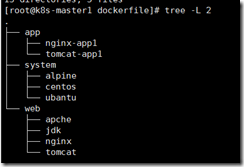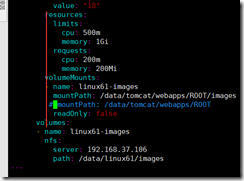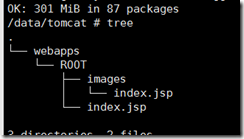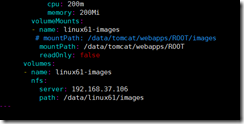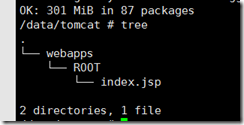Image of nginx based on alpine:
Note: the user shell type created based on alpine must be bin/bash, or the su -c command cannot be executed #/ bin/bash script;
<P>pwd
<P>/data/dockerfile</P>To build a base image:
Build warehouse file
# vim repositories http://mirrors.aliyun.com/alpine/v3.8/main http://mirrors.aliyun.com/alpine/v3.8/community
Write Dockerfile
# vim Dockerfile FROM k8s-harbor.taozi.net/pub-image/alpine:v3.8.1 LABEL maintainer="lijian/20210117" COPY repositories /etc/apk/repositories RUN ln -sf /usr/share/zoneinfo/Asia/Shanghai /etc/localtime && apk update && apk --no-cache add iotop gcc libgcc libc-dev libcurl libc-utils pcre-dev zlib-dev libnfs make pcre pcre2 zip unzip net-tools pstree wget libevent libevent-dev iproute2 openssl-dev
Create build sh:
vim build.sh #!/bin/bash docker build -t k8s-harbor.taozi.net/pub-image/alpine-base:V3.8.1 . docker push k8s-harbor.taozi.net/pub-image/alpine-base:V3.8.1
Create nginx base image:
Enter container command:
<P>docker run -it --rm k8s-harbor.taozi.net/pub-image/alpine-base:V3.8.1 sh </P>
Prepare relevant documents:
mkdir /data/dockerfile/web/nginx/1.18.0-alpine/ -pv cd 1.18.0-alpine/ wget http://nginx.org/download/nginx-1.18.0.tar.gz Remove the from the package nginx.conf,And modify: vim nginx.conf #Add on the second line: daemon off;
Write Dockerfile:
vim Dockerfile FROM k8s-harbor.taozi.net/pub-image/alpine-base:V3.8.1 LABEL maintainer="lijian/20210117" ADD nginx-1.18.0.tar.gz /usr/local/src RUN cd /usr/local/src/nginx-1.18.0 && ./configure --prefix=/apps/nginx \ --user=nginx \ --group=nginx \ --with-http_ssl_module \ --with-http_v2_module \ --with-http_realip_module \ --with-http_stub_status_module \ --with-http_gzip_static_module \ --with-pcre \ --with-stream \ --with-stream_ssl_module && make && make install && ln -s /apps/nginx/sbin/nginx /usr/bin/ && addgroup -g 2022 -S nginx && adduser -s /sbin/nologin -S -D -u 2022 -G nginx nginx COPY nginx.conf /apps/nginx/conf/nginx.conf RUN chown -R nginx.nginx /apps/nginx/ EXPOSE 80 443 CMD ["nginx"]
Create build sh:
vim build.sh #!/bin/bash docker build -t k8s-harbor.taozi.net/pub-image/nginx-base:1.18.0 . docker push k8s-harbor.taozi.net/pub-image/nginx-base:1.18.0
Create nginx business image:
Prepare files and web files
mkdir /data/dockerfile/app/nginx-app1/ -p cd /data/dockerfile/app/nginx-app1/ mkdir html echo Tish is nginx-app1 > html/index.html tar zcfv html.tar.gz html
Write Dkocerfile:
vim Dockerfile FROM k8s-harbor.taozi.net/pub-image/nginx-base:1.18.0 LABEL maintainer="lijian/20210117" ADD html.tar.gz /data/nginx/ COPY nginx.conf /apps/nginx/conf/nginx.conf RUN chown -R nginx.nginx /data/nginx CMD ["nginx"]
Build mirror script:
vim build.sh #!/bin/bash docker build -t k8s-harbor.taozi.net/pub-image/nginx-app1:v1 . docker push k8s-harbor.taozi.net/pub-image/nginx-app1:v1
Start container:
<P>docker run -d -p 8011:80 k8s-harbor.taozi.net/pub-image/nginx-app1:v1 </P>
Operating nginx in k8s environment:
Create a yaml file for the namespace:
mkdir /data/k8s-01-data/yml/linux-61/nginx-app1 -pv vim linux61.yaml kind: Namespace apiVersion: v1 metadata: name: linux61
Create yaml file for nginx-app1:
vim nginx.yaml kind: Deployment apiVersion: apps/v1 metadata: labels: app: linux61-nginx-deployment-lable name: linux61-nginx-deployment namespace: linux61 spec: replicas: 1 selector: matchLabels: app: linux61-nginx-selector template: metadata: labels: app: linux61-nginx-selector spec: containers: - name: linux61-nginx-container image: k8s-harbor.taozi.net/apps/nginx-app1:v1 #command: ["/apps/tomcat/bin/run_tomcat.sh"] #imagePullPolicy: IfNotPresent imagePullPolicy: Always ports: - containerPort: 80 protocol: TCP name: http - containerPort: 443 protocol: TCP name: https env: - name: "password" value: "123456" - name: "age" value: "18" resources: limits: cpu: 500m memory: 1Gi requests: cpu: 200m memory: 200Mi --- kind: Service apiVersion: v1 metadata: labels: app: linux61-nginx-svc name: linux61-nginx-svc namespace: linux61 spec: type: NodePort ports: - name: http port: 80 protocol: TCP targetPort: 80 nodePort: 30001 - name: https port: 443 protocol: TCP targetPort: 443 nodePort: 30443 selector: app: linux61-nginx-selector
Run nginx-app1 using k8s:
<P>kubectl apply -f nginx.yaml </P>
Login using browser
Making tomcat image based on alpine:
Create a jdk image (directly use the underlying image alpine):
Write Dkocerfile:
vim Dockerfile FROM k8s-harbor.taozi.net/pub-image/alpine-base:V3.8.1 LABEL maintainer="lijian/20210117" RUN apk add --no-cache bash openjdk8-jre-base=8.275.01-r0 && rm -rf /var/cache/apk/*
Build mirror script:
vim build.sh #!/bin/bash docker build -t k8s-harbor.taozi.net/pub-image/jdk-base:8.275.01-r0 . docker push k8s-harbor.taozi.net/pub-image/jdk-base:8.275.01-r0
Create tomcat basic image:
Make startup script:
cat > run_tomcat.sh << EOF #!/bin/bash su - www -c "/apps/tomcat/bin/catalina.sh start" su - www -c "tail -f /etc/hosts" EOF chmod a+x run_tomcat.sh
Create test page:
mkdir ROOT echo "this is tomcat-app-base"> ROOT/index.jsp tar czfv ROOT.tar.gz ROOT/
Modify page file path:
The server of the binary file XML, take it out and modify it
vim server.xml appBase="/d
Write Dkocerfile:
vim Dockerfile FROM k8s-harbor.taozi.net/pub-image/jdk-base:8.275.01-r0 LABEL maintainer="lijian" ENV LANG en_US.UTF-8 ENV TERM xterm ENV TOMCAT_MAJOR_VERSION 8 ENV TOMCAT_MINOR_VERSION 8.5.64 ENV CATALINA_HOME /apps/tomcat ENV APP_DIR /webapps ADD apache-tomcat-8.5.64.tar.gz /apps RUN ln -s /apps/apache-tomcat-8.5.64 /apps/tomcat && addgroup -g 2021 -S www && adduser -s /bin/bash -S -D -u 2021 -G www www ADD server.xml /apps/tomcat/conf/server.xml ADD run_tomcat.sh /apps/tomcat/bin/run_tomcat.sh ADD ROOT.tar.gz /data/tomcat/webapps RUN chown -R www.www /apps/ /data/tomcat/ EXPOSE 8080 CMD ["/apps/tomcat/bin/run_tomcat.sh"]
Build mirror script:
cat > build.sh << EOF #!/bin/bash docker build -t k8s-harbor.taozi.net/pub-image/tomcat:8.5.73 . docker push k8s-harbor.taozi.net/pub-image/tomcat:8.5.73 EOF
Test:
Build tomcat business image:
Enter the business directory of tomcat:
# pwd
/data/dockerfile/app/tomcat-app1Create test page:
mkdir ROOT echo "this is tomcat-app-11111"> ROOT/index.jsp tar czfv ROOT.tar.gz ROOT/
Write Dkocerfile:
FROM k8s-harbor.taozi.net/pub-image/tomcat:8.5.73 LABEL maintainer="lijian" ADD ROOT.tar.gz /data/tomcat/webapps ADD server.xml /apps/tomcat/conf/server.xml RUN chown -R www.www /apps/ /data/tomcat/ EXPOSE 8080 CMD ["/apps/tomcat/bin/run_tomcat.sh"]
Build mirror script:
cat > build.sh << EOF #!/bin/bash docker build -t k8s-harbor.taozi.net/apps/tomcat-app1:v1 . docker push k8s-harbor.taozi.net/apps/tomcat-app1:v1 EOF
test
Running tomcat in k8s environment:
Create the yaml file of tomcat-app1:
vim tomcat-app1.yaml kind: Deployment apiVersion: apps/v1 metadata: labels: app: linux61-tomcat-app1-deployment-lable name: linux61-tomcat-app1-deployment namespace: linux61 spec: replicas: 1 selector: matchLabels: app: linux61-tomcat-app1-selector template: metadata: labels: app: linux61-tomcat-app1-selector spec: containers: - name: linux61-tomcat-app1-container image: k8s-harbor.taozi.net/apps/tomcat-app1:v1 #command: ["/apps/tomcat/bin/run_tomcat.sh"] #imagePullPolicy: IfNotPresent imagePullPolicy: Always ports: - containerPort: 8080 protocol: TCP name: http env: - name: "password" value: "123456" - name: "age" value: "18" resources: limits: cpu: 500m memory: 1Gi requests: cpu: 200m memory: 200Mi --- kind: Service apiVersion: v1 metadata: labels: app: linux61-tomcat-app1-svc name: linux61-tomcat-app1-svc namespace: linux61 spec: type: NodePort ports: - name: http port: 8080 protocol: TCP targetPort: 8080 nodePort: 30002 selector: app: linux61-tomcat-app1-selector
Run nginx-app1 using k8s:
<P>kubectl apply -f tomcat-app1.yaml </P>
Login using browser
nginx+tomcat in k8s realizes dynamic and static separation:
Rebuild the business image of nginx and add upstream:
Modify the configuration file of nginx:
vim nginx.conf #The upstream statement block is within the http statement block, and the url cannot be underlined: upstream tomcat-app1 { server linux61-tomcat-app1-svc.linux61.svc.taozi.local:8080 weight=1 fail_timeout=5s max_fails=3; } server { ...... #The location statement block is within the server statement block location ~* \.jsp$ { proxy_pass http://tomcat-app1; proxy_set_header X-Forwarded-For $proxy_add_x_forwarded_for; proxy_set_header X-Real-IP $remote_addr; } ...... }
Rebuild mirror:
bash build.sh
Delete the original nginx pod:
kubectl delete linux61-nginx-app1-deployment-5bbc8745d7-w45g4 pod -n linux61
The node will pull the image again, and the reconstruction is successful:
You can also use yaml file to delete the original pod and create a new one in Shuyong yaml file:
kubectl delete -f nginx.yaml
kubectl apply -f nginx.yamlExperiment with web pages:
Dynamic and static separation based on NFS:
Prepare nfs server: host 192.168.37.106
yum install nfs-util -y mkdir /data/linux61/{static,images} -pv echo "this is nginx-app1-static" > /data/linux61/static/index.html echo "this is tomcat-app1-images" > /data/linux61/images/index.jsp stay /etc/exports Add the following line to the file: vim /etc/exports /data/linux61/ 192.168.37.0/24(rw,no_root_squash) systemctl enable --now nfs Experiment with mount and read-write functions on other hosts: mount -t nfs 192.168.37.106:/data/linux61 /mnt cp /etc/hosts /mnt/
Modify the yaml file of nginx-app1:
Note: #volumes belongs to deployment spec.template. The level of spec is one level higher than volumeMounts: and you should pay attention to the format when writing
cd /data/k8s-01-data/yml/linux-61/nginx-app1/ #volumeMounts and resources: both belong to deployment spec.template. Sub options in spec.containers volumeMounts: - name: linux61-static mountPath: /data/nginx/html readOnly: false #volumes belong to deployment spec.template. The level of spec is one level higher than volumeMounts: and you should pay attention to the format when writing volumes: - name: linux61-static nfs: server: 192.168.37.106 path: /data/linux61/static
yaml file to which nginx is applied:
<P>kubectl apply -f nginx-app1.yaml </P>
Modify the yaml file of tomcat-app1:
vim tomcat-app1.yaml #Add the following at the end of the statement block of containers: volumeMounts: - name: linux61-images mountPath: /data/tomcat/webapps/ROOT/images # mountPath: /data/tomcat/webapps/ROOT readOnly: false volumes: - name: linux61-images nfs: server: 192.168.37.106 path: /data/linux61/image
Start a new pod: kubectl apply -f tomcat-app1.yaml
Test:
Mount relationship notes:
First mount
It is equivalent to the coincidence of two images files. The original ROOT file index JSP has not changed. The files in the images directory are nfs files;
Relationship of the second mount
For the directory in the container, the images file under nfs coincides with the ROOT file, and the name is subject to ROOT, but the file inside is already a file under nfs, but the original ROOT file is overwritten by the mount relationship;
Commands used:
kubectl get service -A -o wide kubectl get pods -A -o wide kubectl get nodes-A -o wide kubectl get deployment -A kubectl get deployment -n linux61 -o wide kubectl describe svc linux61-nginx-app1-svc -n linux61 #Query the details of an svc kubectl describe deployment -n linux61 #Query the deployment details of a namespace kubectl create -f tomcat-app1.yaml kubectl apply -f tomcat-app1.yaml kubectl delete -f tomcat-app1.yaml kubectl create -f tomcat-app1.yaml --save-config --record kubectl apply -f tomcat-app1.yaml --record #Recommended command kubectl exec -it linux61-tomcat-app1-deployment-6bccd8f9c7-g76s5 sh -n linux61 #Enter a pod kubectl logs linux61-tomcat-app1-deployment-6bccd8f9c7-g76s5 -n linux61 #Query the log of a pod kubectl delete pods linux61-tomcat-app1-deployment-6bccd8f9c7-g76s5 -n linux61
